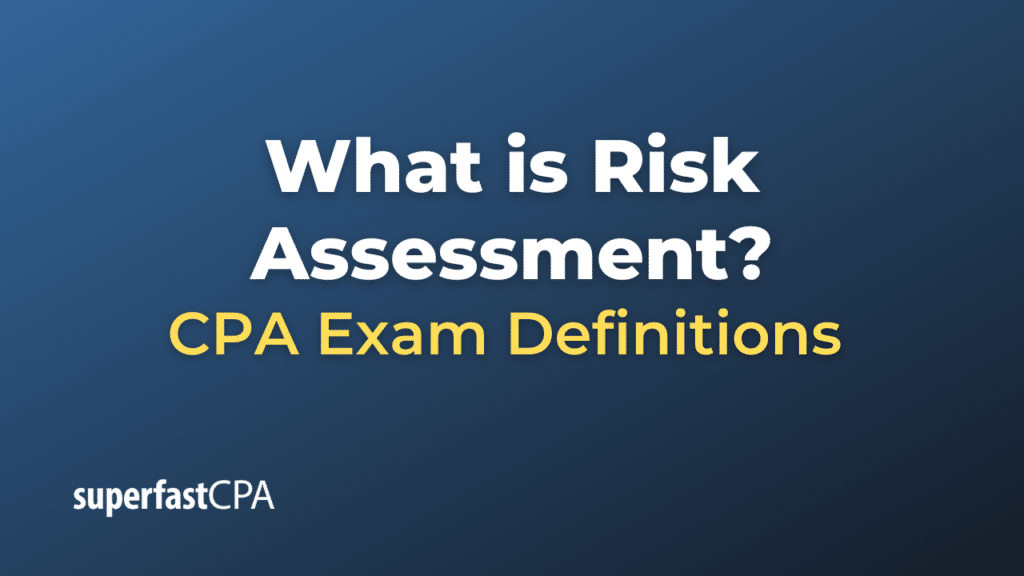Risk Assessment
Risk assessment is a systematic process of evaluating the potential risks that may be involved in a projected activity or undertaking. It is a critical component of risk management, which involves identifying, analyzing, evaluating, and ultimately treating potential risks to ensure they are within acceptable bounds.
Risk assessment can be applied to various domains, including business, health, environment, and information technology, among others. The core purpose is to determine the magnitude of potential adverse outcomes and the likelihood of their occurrence, allowing decision-makers to make informed choices about how to manage these risks.
The general steps involved in a risk assessment process include:
- Hazard Identification: Determine and list potential hazards or threats. In a business context, this could involve financial risks, operational risks, or strategic risks. In a health context, it could be exposure to harmful chemicals or procedures.
- Vulnerability Analysis: Determine what or who might be adversely affected. For instance, in a cybersecurity context, this would involve identifying which systems or data might be vulnerable to a potential breach.
- Probability Determination: Assess the likelihood that the risk will occur. This can be done using historical data, expert judgment, or statistical methods.
- Consequence Analysis : Evaluate the potential impact if the risk does materialize. For a business, this could be in terms of financial losses, reputational damage, or operational disruption.
- Risk Evaluation: Combine the likelihood and the potential impact to determine the level of risk. This helps in ranking or prioritizing the risks.
- Risk Treatment/Management: Decide on strategies to manage or mitigate the risks. This could involve avoiding the risk, transferring it (like buying insurance), mitigating it (implementing controls or precautions), or accepting it.
- Monitoring and Review: Regularly review the risk assessment to account for any changes in context, environment, or other factors. Update the risk management strategies accordingly.
For instance, in an industrial setting, a risk assessment might identify that workers are exposed to a chemical that has a certain probability of causing health problems. The potential impact or consequence of this exposure would be evaluated in terms of health outcomes. Based on this analysis, protective measures like improved ventilation, protective equipment, or substituting a less hazardous chemical might be implemented.
It’s essential to note that no activity is entirely without risk. Risk assessment helps in understanding and managing these risks to ensure that they are kept at an acceptable level while pursuing desired outcomes or benefits.
Example of Risk Assessment
Company ABC is a well-known manufacturer of home appliances. They are considering introducing a new, innovative coffee maker to the market.
1. Hazard Identification:
- Potential defects in the manufacturing process leading to malfunctioning units.
- Possibility of the new product not being accepted well by the target audience.
- Risk of intellectual property theft or infringement if the product has unique features not patented.
2. Vulnerability Analysis:
- Certain batches of products might be more vulnerable to defects if sourced from a particular supplier.
- The product’s marketing might not resonate with certain demographic groups.
- Competitors might be actively looking for new innovations to replicate.
3. Probability Determination:
- Past products from the same manufacturing line had a defect rate of 2%.
- Market research suggests that 20% of new products in this category don’t achieve projected sales.
- There have been two instances in the past five years where competitors launched similar products shortly after ABC’s release.
4. Consequence Analysis:
- Defective products could lead to recalls, customer dissatisfaction, and potential legal issues.
- If the product doesn’t resonate, there could be a large unsold inventory, leading to financial losses.
- Intellectual property theft or duplication can erode the product’s unique value proposition and market share.
5. Risk Evaluation:
- Defect-related risks are deemed high due to potential financial and reputational damages.
- Market acceptance risk is medium, given the company’s strong brand and marketing capabilities.
- Intellectual property risk is considered medium-to-high, considering past instances and the competitive landscape.
6. Risk Treatment/Management:
- Enhance quality control checks and source high-quality materials to reduce manufacturing defects.
- Develop a robust marketing and engagement strategy to ensure product appeal. Also, consider pilot testing in selected markets.
- Fast-track patent applications and monitor the market for potential infringements. Maybe even consider a staggered or secretive launch.
7. Monitoring and Review:
- After the product launch, continually monitor defect reports and address them promptly.
- Analyze sales data and customer feedback to gauge market acceptance and adjust strategies if necessary.
- Stay vigilant about competitor products, ensuring swift legal action if any infringement is detected.
By conducting this risk assessment, Company ABC can make informed decisions about how to proceed with its product launch, ensuring that potential issues are anticipated and addressed proactively.













